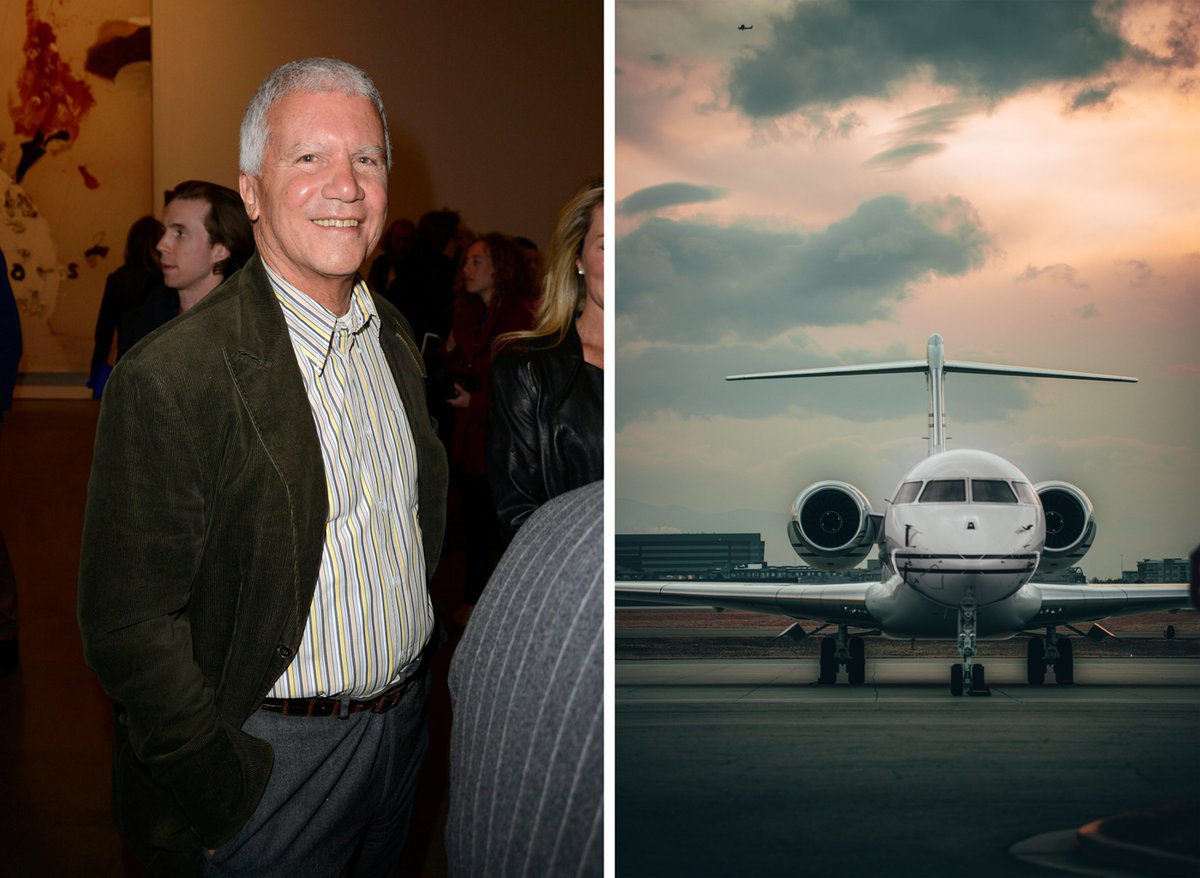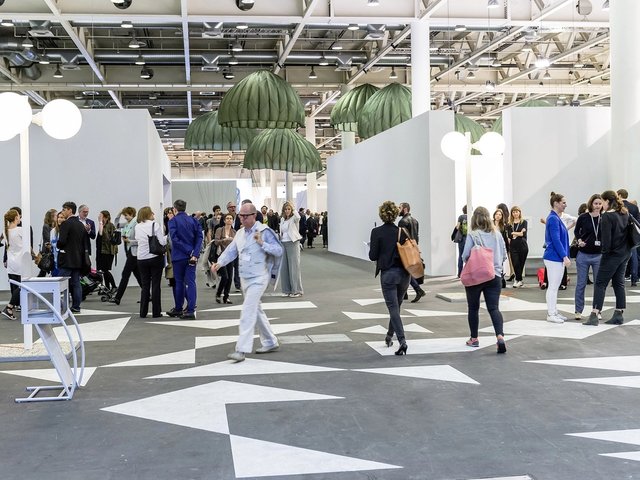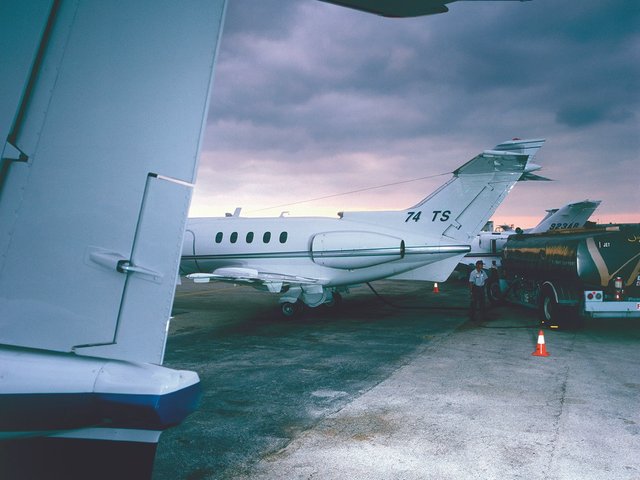With swathes of Europe ablaze this summer, the prospect of leaping onto a plane and heading for a sun-soaked holiday may seem less than appealing. But for the super-rich—and this demographic includes many prominent art collectors, gallerists and artists—the lure of taking to the skies appears undiminished at any time of the year, especially when using private aviation.
Despite much talk of a more environmentally aware “new normal” post-Covid, a recent study by the UK-based charity Possible points to an explosive growth in the private jet market since the pandemic. According to Possible’s report, one in ten departures from UK airports alone are now private jet flights, and this trend is being echoed in the more affluent cities and nations worldwide.
It is now widely known that flying is the most impactful of all forms of travel and that private jets are, per capita, by far the most polluting way to get around. The reason for private aviation’s smouldering carbon footprint is that, in addition to the escalating number of private jets in the air, these planes tend to fly at very low occupancy rates, with an average passenger load of around two to three bums on seats. The largest and most carbon-intense categories of private jet still average around the same number of passengers, meaning their empty return journeys are included, they have an occupancy (or load factor, to use the technical term) of less than 20%, often with as many crew members as passengers. These bigger, underfilled private jets are 20 or even 30 times more carbon-intensive than economy class airline flights. To deliver another shocking statistic, even a typical four-hour flight in a private jet produces the same amount of CO2e emissions as an average person does in an entire year.
None of this seems to have elicited any change in attitude from the powers that be. It was bad enough when last week UK prime minister Rishi Sunak decided to issue 100-plus new licences for companies to drill for oil and gas in the North Sea, but to add insult to injury, he also commandeered an RAF jet that whisked him up to Aberdeen to make the announcement. Like so many of his well-heeled buddies, Sunak (whose net worth is around £730m) seems addicted to private jets and helicopters, even for the shortest of journeys.

UK Prime minister Rishi Sunak boards an RAF plane as he heads off to visit a healthcare centre in Leeds in January 2023
Photo: No 10/Flickr
And the art world is no better. A recent New Yorker profile of mega dealer Larry Gagosian revealed that he shuttles around his global empire of 19 gallery spaces on his $60m Bombardier Global 7500 private jet. In 2012, for the convenience of his fellow jet setting clientele, Gagosian opened a gallery in the grounds of Le Bourget airport outside Paris, so his clients can buy art upon landing in their private crafts.
Interior of Larry Gagosian's private jet from AB to NYC. pic.twitter.com/PP4t1FaEUx
— Jerry Saltz (@jerrysaltz) December 7, 2014
For all their lip service to sustainability, the upper echelons of our sector are not only continuing their use of private jets but are also being actively courted and encouraged to do so. This year the private luxury jet company NetJets celebrates a 22-year partnership with Art Basel, stating proudly on its website that “Art Basel is dedicated to connecting members of the international art world, and to providing a space for their ideas and creativity to be celebrated. NetJets is incredibly proud of our longstanding partnership with the illustrious art fair”.
In something of an irony bypass, the NetJets VIP members-only lounge at this year’s Art Basel in Basel took a “luxury safari theme” which included large paintings of lions and leopards by the South Africa-born, Swiss-based artist Conor McCreedy. The works were part of McCreedy’s Alter Ego Wildlife series, which apparently—according to the NetJets website—focus “on the complex relationship between oneself and the natural world as well as the artist’s passion for conservation.” A relationship, one can’t help thinking, that would be fundamentally improved by the abolition of private jets.
#NetJets collaborated with Conor Mccreedy at this year's Art Basel for an immersive safari experience. #OnlyNetJets pic.twitter.com/daxDV2YHWi
— NetJets (@NetJets) June 22, 2023
Other jet companies are also keen to tap into high-net-worth artworlders. At the time of writing the website of private jet company VistaJet declares itself to be Global VIP partner of Frieze Art Fairs, stating that “80% of VistaJet Members are collectors and many share their passion for the arts by lending artworks to the most prominent museums around the world, as well as supporting their growth through patronage and donations.”
However this particular marriage is now apparently over, with a Frieze spokesperson firmly stating that “Frieze is no longer partnering with VistaJet and we will be focusing on other product and service category partners going forward.” But while Frieze’s severance from this most polluting of associations is to be applauded, it remains doubtful whether the termination of the partnership will result in a mass grounding of all those art-collecting VistaJet members who apparently include many major gallerists and collectors. (You know who you are…)
So what can be done to make the affluent art world abandon its penchant for swanky craft and, if it has to fly, board a commercial plane alongside the civilians? This is a hard question to answer given that, despite their protestations that they are making every effort to be more sustainable, private jet companies are still paying much less for their emissions than their commercial counterparts. Not only does the fuel for private jets receive the same tax subsidies as that of commercial airlines but, because they are flying on planes lighter than the 5.7 tonne threshold, the passengers on one in five private jets also pay no Air Passenger Duty (APD). Those flying on just over half the UK’s private jet flights still only pay the same APD as commercial Premium Economy passengers. No wonder Possible’s report which outlines all these stats has a title beginning “Jetting away with it”…
The costs of flying privately are obviously substantially higher than commercial flights, but these exemptions/subsidies send out an ominous signal that in the eyes of UK law, and most likely the law of many other countries as well, this form of travel is being rewarded rather than penalised for its heavy environmental impact.
Given existing information on how unsustainable private planes are appears to be having no effect on those that use them, and given legislation to deter their use shows no sign of being passed in the UK – or anywhere else – anytime soon, it seems all that can be done for the time being is to make having your personal aircraft purring on the runway a badge of shame rather than one of status. This means calling out those gallerists, collectors, artists and organisations (especially those who make a particular point of signalling their green credentials) for refusing to relinquish these mega-polluters. And if you are offered a trip in a private jet (or helicopter), however important its owner, just say NO!






